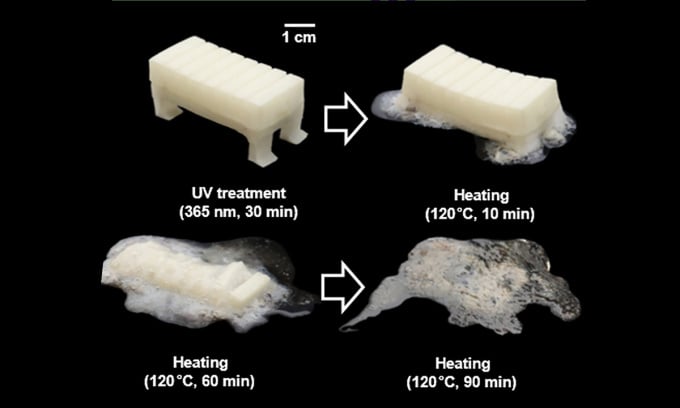In the test, a 3cm long robot made of silicone plastic mixed with a compound completed the reconnaissance mission, reported the results and self-destructed.

The robot decomposes at 120 degrees Celsius after exposure to ultraviolet light. Photo: Science Advances
In an effort to create robots that can control their own life cycles, a team of South Korean researchers has developed tiny, soft devices that can melt themselves into a puddle, Science Alert reported on September 10. The new research was published in the journal Science Advances.
“We simulated death in a life cycle where the robot can terminate itself,” said Min-Ha Oh, an engineer at Seoul National University. The “death” is triggered when ultraviolet LEDs inside the robot destabilize its chemical composition. The process takes about an hour.
The 3-centimeter-long robot body is made of diphenyliodonium hexafluorophosphate mixed with silicone resin. These materials allow the robot to be rigid but flexible enough to crawl across surfaces like a four-legged inchworm. The robot is powered by compressed air.
Unlike traditional robots with limited degrees of freedom, soft robots exhibit good adaptability and can perform complex movements, such as handling fragile objects or adapting to unstable environments, according to the research team. This could be useful for tasks such as delivering drugs to specific targets in hard-to-reach places on the human body, disaster areas, or deep under the sea.
Oh and his colleagues tested the new robot's reconnaissance mission. Equipped with ultraviolet, temperature, and deformation sensors, the small robot successfully approached a gun and measured its temperature, then retreated to a safe location to report the results and trigger a self-destruct sequence.
Exposure to ultraviolet light causes the diphenyliodonium hexafluorophosphate to convert to fluoride, weakening the entire structure to the point where high temperatures cause it to melt. The robot disintegrates completely, leaving behind only a viscous pool of silicone and disintegrated thin-film electronics.
However, the puddle contained fluoride ions that could be toxic, so the team added calcium chloride to help neutralize them. The team said more research is needed to improve the environmental impact of the viscous liquid.
Thu Thao (According to Science Alert )
Source link





































































































Comment (0)